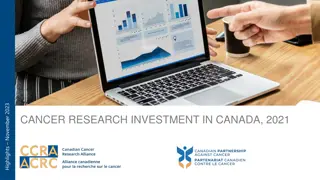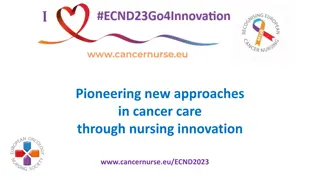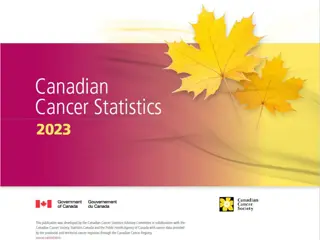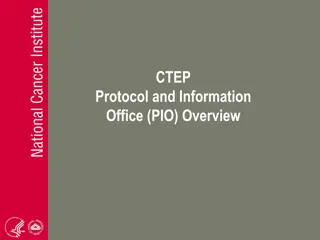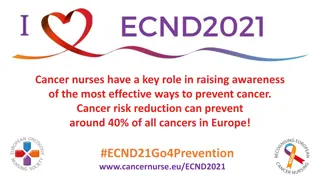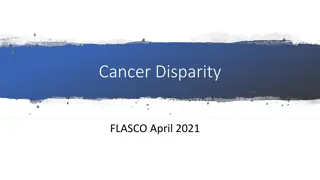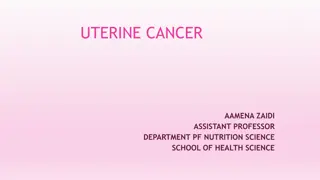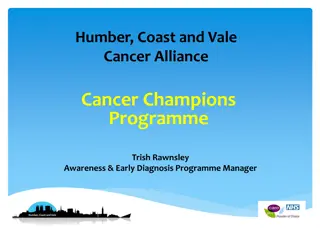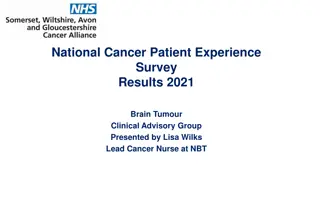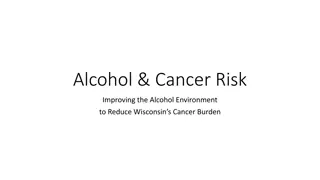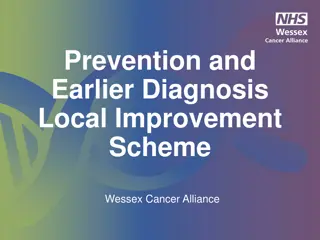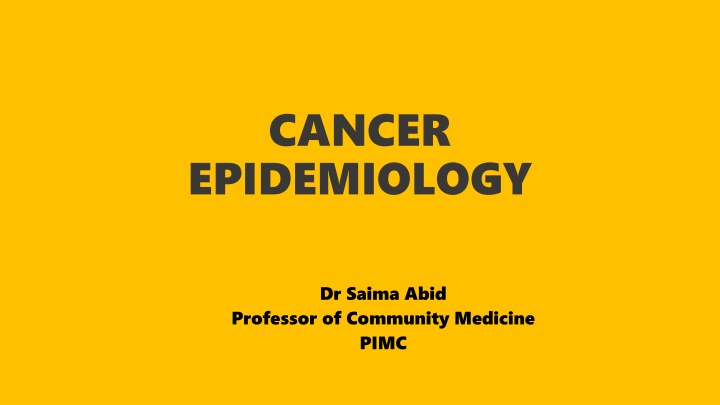
Cancer Epidemiology, Risk Factors, and Prevention
Delve into the world of cancer epidemiology, exploring risk factors, prevalent cancers, burden of the disease, and prevention strategies. Discover the history of cancer, its definition, and the global impact it has on society. Uncover crucial insights to enhance your knowledge of this widespread disease.
Download Presentation

Please find below an Image/Link to download the presentation.
The content on the website is provided AS IS for your information and personal use only. It may not be sold, licensed, or shared on other websites without obtaining consent from the author. If you encounter any issues during the download, it is possible that the publisher has removed the file from their server.
You are allowed to download the files provided on this website for personal or commercial use, subject to the condition that they are used lawfully. All files are the property of their respective owners.
The content on the website is provided AS IS for your information and personal use only. It may not be sold, licensed, or shared on other websites without obtaining consent from the author.
E N D
Presentation Transcript
CANCER EPIDEMIOLOGY Dr Saima Abid Professor of Community Medicine PIMC
Scenario Scenario Every ninth out of ten women are at risk of developing Breast Cancer in Pakistan. What are the risk factors for the Breast Cancer?
LEARNING OBJECTIVES 1. To be able to define cancer 2. To comprehend history of cancer 3. To understand the burden of cancers 4. To comprehend about the most Prevalent Cancers 5. To determine the causes of cancers 6. To understand the concept of prevention of Cancer
Definition of Cancer Group of diseases characterized by: Abnormal growth of cells Ability to invade adjacent tissues & distant organs Death of affected person if tumor progressed beyond that stage when it can be successfully removed. CANCER CAN OCCUR AT ANY SITE & MAY INVOLVE ANY TYPE OF CELLS.
HISTORY OF CANCER Cancer not a new disease. Hippocrates father of medicine introduced term carcinoma from Greek word karkinos , for crabs. Symptoms also described in Chinese & Arabic medical writings. 600 years later, Galen distinguished three types of tumour
HISTORY OF CANCER End of 18th century cancer began to be studied systematically and intensively. Bichat (1771-1802) father of histology suggested cancer an 'accidental formation' of tissue. Decades later, M ller (1801-58), Virchow (1821-1902) used microscope to show that cancerous tissue was made up of cells (Long, 1928).
B BURDEN URDEN O OF F T THE HE D DISEASE ISEASE - - WORLD WORLD 1. Approx.18 million cancer cases around the world in 2020. Of these 9 in men & 8.8 million in women. 2. New cases expected to rise by about 22 million/ yr over the next 2 decades. 3. Sixth leading cause of death globally, 8.8 million deaths in 2015. 4. Globally, 1 in 6 deaths is due to cancer.
B BURDEN URDEN O OF F T THE HE D DISEASE ISEASE - - WORLD WORLD 1. Approx. 70% of deaths in low & middle income countries. 2. Age standardized cancer incidence rate 25% higher in men than in women 3. 205 & 165 per 100,000 pop respectively.
PROBLEM STATEMENT <60 % of the world total cases occur in Africa, Asia, central & south America Accounts for 70 % of all world cancer deaths, due to lack of early detection & access to treatment. Most common cancers among Males are Lung, Prostate, Colorectum.
PROBLEM STATEMENT Female: Breast, Colorectum, Cervix Both genders: Lung, Breast, Colorectum Mortality: Lung, Liver, stomach Westernization trends , increase in Breast, Prostate, Cervical & Colorectal cancers.
MOST COMMON CANCER IN PAKISTAN MOST COMMON CANCER IN PAKISTAN Overall breast cancer (approx. 31.8%) Cancers of lip & oral cavity (19.2%) Colorectal (7.0%) Non-melanoma skin cancers (NMSC) (6.9%). Esophageal Cancer (5.8%), Oral cavity & gastrointestinal cancers: the most common cancer of male in Pakistan
Cancer in Pakistan Major socio- economic inequalities Access to health care Imbalance distribution of power Social determinants of Health Fragile Public health system
TYPE OF CANCERS 1.Carcinoma 2.Sarcoma 3.Lymphoma PRIMARY & SECONDRY TUMOUR
MAJOR CAUSES OF CANCER : Environmental factors, tobacco use, alcohol, food habits, (GERD) and Barrett's esophagus , infection HBV, HCV, HPV, EBV, helicobacter pylori, liver fluke, dietary factors, lack of physical activity , radiations, chemical exposures, genetic factors.
WHAT CAUSES CANCER ? Breast cancer risk factors Estrogen exposure: early menarche (<12), late menopause (>55), never breast fed, hormone therapy, late child bearing: >30 years breast density, obesity after menopause, physical inactivity, alcohol consumption, radiation exposure, genetic alterations: BRCA1, BRCA2 genes mutation, family history.
CANCER SCREENING Search for unrecognized malignancy by means of rapidly applied tests Methods of screening: 1. Mass screening by comprehensive cancer detection examination 2. Selective screening 3. Screening for cancer Cervix i.e. Pap smear 4. Screening for Breast cancer i.e. breast self-examination, by a physician, mammography
CHALLENGES Illiteracy Lack of awareness & information Taboos and social stigma Affordability and accessibility Inadequate medical facilities and Infrastructure Absence of a national cancer registry Lack of national cancer prevention program Lack of Specialized Human Resource
PREVENTION PREVENTION 1.Control of tobacco & alcohol consumption 6.Foods, drugs & cosmetics 2. Personal hygiene 7.Air pollution 3. Radiation 8.Dietary Habits 4. Occupational exposures 5. Immunization
PREVENTION 1.Good & balanced diet 2.Daily exercise 3.Active life 4.Weight reduction 5.Avoid un prescribed medicines / self medication nutrition, healthy 6.Legislation 7.Cancer education 8.Cancer registration including hospital & population based registries 9.Early detection & prompt treatment
WAY FORWARD 1. Need of political commitment and action. 2. Preventive measures i.e. elimination of use of tobacco products, Alcohol, sources etc.
MCQS MCQS 40 years old man 40 years old man Z Zahid with complaint of with complaint of leukoplakia, bleeding from the mouth and sudden weight bleeding from the mouth and sudden weight loss. Physician is suspecting oral carcinoma after complete examination. Cancer loss. Physician is suspecting oral carcinoma after complete examination. Cancer is characterized by all of these features EXCEPT: is characterized by all of these features EXCEPT: 1. 1. Abnormal growth of cells Abnormal growth of cells 2. 2. Ability to invade adjacent tissues & distant Ability to invade adjacent tissues & distant organs 3. It is a contagious disease 4. 4. Death of affected person if tumor Death of affected person if tumor progressed. progressed. 5. 5. Cancer can occur at any site & may involve any type of cells. Cancer can occur at any site & may involve any type of cells. ahidwith the history of tobacco & Alcohol use visited OPD with the history of tobacco & Alcohol use visited OPD organs
MCQs MCQs Every ninth out of ten women are at risk of developing Breast Cancer in Pakistan. All of these are risk factor for the Breast Cancer except: 1. Prolong Estrogen exposure 2. Radiation exposure 3. BRCA1, BRCA2 genes mutation 4. Family history 5. Injury to the Breasts


